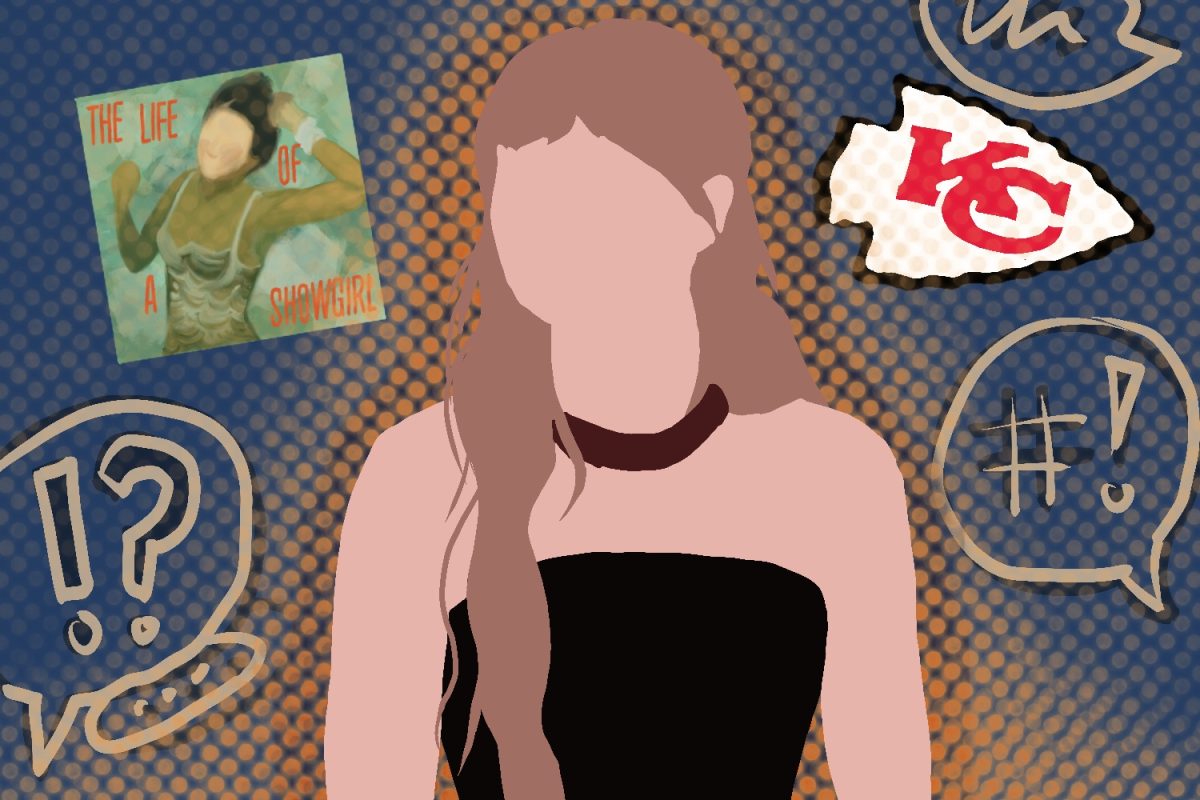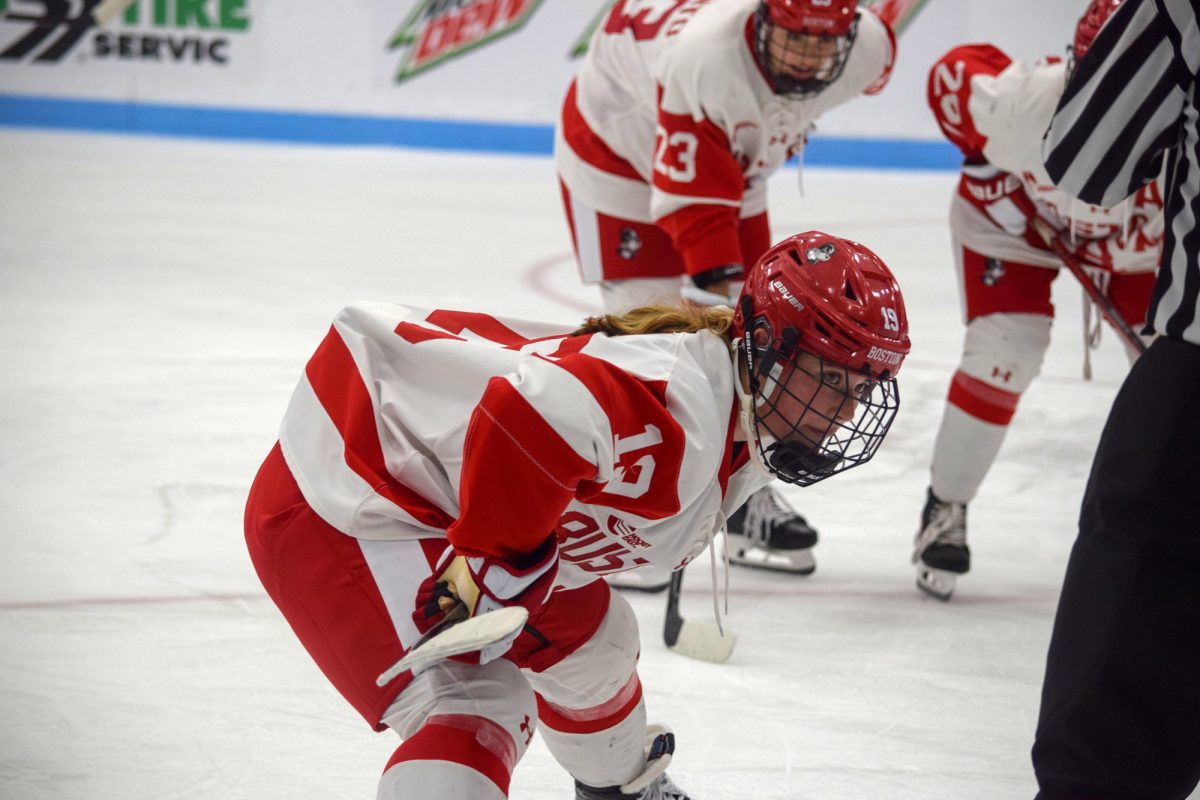Veteran defensemen Kevin Shattenkirk and Colby Cohen lined up against freshmen forwards Wade Megan and Justin Courtnall in a typical 2-on-2 drill at last Wednesday’s men’s hockey practice.
Megan sped across center ice and decided to take the puck wide right as he approached the offensive zone. But before he got to the blue line, Shattenkirk, chewing half of his mouth guard while the other half hung at the side of his face, cut him off and slammed him into the boards with a crushing body check.
Some fans may question why the team captain would finish such a hard hit against a freshman, but Shattenkirk didn’t see any other option.
‘I think if someone sees me let up on a hit like that, then they’ll maybe let up in a drill or something,’ the New Rochelle, N.Y. native said. ‘But if the freshmen see me putting a hard hit on someone, that kind of forces them to step their game up.’
It’s that kind of lead-by-example, never-back-down attitude that has earned Shattenkirk enough admiration from his teammates to be elected Boston University’s first junior captain in 32 years.
‘He really commands respect from the guys,’ Cohen said of his defensive partner of two years. ‘He’s a guy that’s really well-liked by everyone. So, it’s easy to play hard and listen to what he has to say because guys respect him. He’s not always yapping. It’s more what he does. He’s always there and ready to play. And he’s a big-time player, too.’
And he has been a big-time player for a long time. Shattenkirk moved away from home at age 16 in the summer of 2005 and headed for Ann Arbor, Mich. to join the U.S. National Team Development Program, which has served as a breeding ground for 45 National Hockey League players since its inception 13 years ago.
Shattenkirk is poised to join those ranks once he’s done playing on Commonwealth Avenue, as evidenced by his being drafted in the first round (14th overall) of the 2007 NHL Entry Draft by the Colorado Avalanche and earning Second-Team All-American honors last year, accolades that he attributes in large part to his two years with the USNTDP.
‘I think I went there with a lot of the raw materials to become a better player, and my coaches there really just kind of took everything that I had and really completed it and turned me into a better player,’ he said. ‘I enjoyed the experience. It was great living away from home and kind of getting used to that before I came to college. It was tough at first, but in the end, it was probably one of the best decisions I’ve made.’
The offensive-minded blue-liner quickly distinguished himself, as he was named captain of the Under-17 team that fall and went on to lead the team in scoring in the 2006 North American Hockey League playoffs.
A year later, Shattenkirk found himself wearing the ‘C’ again, this time as the leader of the Under-18 team. And again, the curly-haired teen left his mark, recording 34 points (12 goals, 22 assists) in 48 games and collecting top defenseman honors at the 2007 World Championships, where the U.S. won the silver medal.
‘When you’re a captain for a team, it’s an honor. And to be a captain of a team that’s representing your country is even more special,’ Shattenkirk, who also served as an alternate captain for Team U.S.A. at last year’s World Junior Championships., said ‘When you see that U.S.A. jersey with your name and a ‘C’ on it, it really means a lot and you really want to represent your team that much more.’
Next up on his to-do list was deciding where to go to school. All the top hockey programs came calling for the now-elite prospect, but Shattenkirk decided on BU because of its location in the heart of Boston, its hockey tradition and its legendary coach, Jack Parker.
Shattenkirk entered his freshman season as one of the most highly touted rookies in the country. But it wasn’t all smooth skating, on or off the ice -‘-‘- at least not right away.
Like any first-year college student, the economics major had to adapt to tougher classes and more homework. Unlike most of his peers, though, he had to do it while spending up to four hours a day on the ice, in the video room or in the weight room, not to mention playing two games a weekend.
‘I think off the ice was the hardest ‘-‘- just learning how to take my school schedule and my homework schedule and balance that out with hockey,’ Shattenkirk said. ‘Once I got out of the rink, I’d go right home and knock out my homework as soon as I could. On the ice, the game itself just completely changed. It was a lot faster and guys were so much stronger.’
Those faster and stronger players caused problems for the newcomer right away. In the Terriers’ home-opener, the University of New Hampshire’s own freshman phenom, James van Riemsdyk, made Shattenkirk look silly on a 1-on-1 that ended with van Riemsdyk roofing a wrister over goalie Brett Bennett’s left shoulder.
Unfortunately for BU, that wouldn’t be the only time Shattenkirk was beat 1-on-1. He continued to get caught on his heels and not keep his man in front of him.
‘I think early in my freshman year, I struggled a lot defensively,’ Shattenkirk said. ‘It was just a lot of simple things that I wasn’t doing ‘-‘- a lot of the small things. Coach Parker and coach [David] Quinn stayed on me a lot and just reinforced everything until it became kind of muscle memory. I think that was very important. As frustrating as it got, they just kept pushing me to keep working at it and keep working at it, and it paid off.’
Mistakes corrected, Shattenkirk excelled in the second half of the season, and was rewarded with a spot on the Hockey East All-Rookie Team after leading all freshman defensemen with 21 points (4 goals, 17 assists).
The progress carried into his sophomore season. Shattenkirk ranked fourth among conference defensemen with 28 points (7 goals, 21 assists) and developed into one of the best power-play quarterbacks in the nation. But perhaps more importantly, he continued to improve on defense. Sure, there were still mistakes, but no one was getting by him 1-on-1 without a fight.
‘I think his growth has been strictly defensively,’ Parker said. ‘He was always great offensively. From day one, he was playing the power play for us. There was no question he was going to be a terrific offensive defenseman, and he is. The real difference is he’s gotten much, much better defensively ‘-‘- playing the initial rush, playing guys out of the corner, covering guys, making decisions, knowing when to go and when not to go. And he’s gotten much better killing penalties.’
Now Shattenkirk faces a new challenge this year ‘-‘- captaining the defending national champions. But he doesn’t see it so much as a challenge than as a great form of motivation.
‘It really pushes me to step up my game in every sense of my hockey life,’ he said. ‘On and off the ice, I really just push myself even harder because I know that I’m gonna have to be a big role model for a lot of the guys on the team.’
Parker said he has no concerns about Shattenkirk being that role model, even if he is only a junior.
‘You want your captain to be the type of guy who impresses people around here ‘-‘- in the dressing room, around the campus, at social events, with the press, whatever it may be,’ he said. ‘And he’s certainly that. He’s a very mature kid. He does really well in school. He’s somebody people look up to.
‘First of all, you look up to him because he gets so much ice time and he’s important to the team. But they also look up to him because he has a good work ethic. He knows when it’s time to get down to hard work. He’s more concerned about how the team does than how he does, and that’s what you need out of a leader.’
So, if there are no more questions about his defense and there aren’t any questions about his ability to lead, there’s only one question left to be answered about Shattenkirk: What’s up with the mouth-guard-half-hanging-out look?
‘I wish I knew,’ he said with a smile. ‘I think it was just a bad habit that I picked up. I get yelled at for it every weekend by my parents.’


















































































































